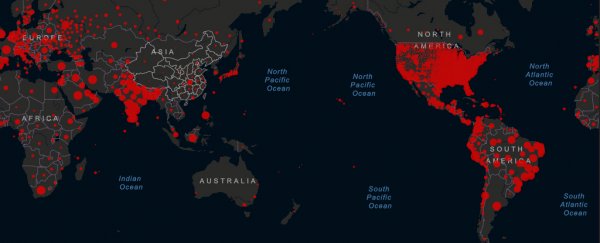Since its emergence at the end of 2019, the novel SARS-CoV-2 coronavirus has spread into the far corners of the world, taking the lives of young and old, rich and poor.
At the end of March 2020, over 40,000 people had died from the virus. By early September, the total number of confirmed deaths worldwide from the novel coronavirus SARS-CoV-2 exceeded 850,000.
Exact numbers vary by a few thousand deaths, depending on the source. Tools such as those produced by Johns Hopkins University break down COVID-19 statistics on regular basis, which although precise, are only as accurate as the methods used to collect the data.
Estimates calculated by bodies such as the World Health Organisation are typically based on tallying medical evaluations that link a positive SARS-CoV-2 test with complications believed to be responsible for a cause of death.
Given limited testing capabilities around the world, underreporting and time lags of regional statistics, as well as the probability of complications going undiagnosed (especially early in the pandemic), the true count is likely to be much higher.
How do we know when someone has died from COVID-19?
The simple answer is we don't know for sure, though it's likely to be far higher than reported estimates.
Unlike the 'manner of death', which distinguishes natural deaths like illness from suicide or homicide, a 'cause of death' ascribes a catalogued illness or chain of events to a person's loss of life.
In many jurisdictions around the world, a cause of death is determined by a pathology expert, who assigns a code from the International Classification of Diseases to allow for easier reporting to international authorities.
This might be straightforward in some cases where a patient with a positive blood result for SARS-CoV-2 has few (if any) pre-existing conditions.
Among patients already dealing with illnesses such as cancer, asthma, diabetes, or chronic obstructive pulmonary disease, the medical events leading to their death are likely to be more complicated.
In such cases a pathology official would need to determine if the patient could have lived longer, were it not for the additional health impact of their coronavirus infection.
How would we determine an accurate number of COVID-19 deaths?
One method for estimating a more accurate total mortality for COVID-19 is to compare the total number of deaths for all causes during the pandemic with relevant statistics from a similar period in previous years.
For example, by the end of July 2020, within a sample of 32 countries and 4 major cities, roughly 413,000 deaths were officially attributed to COVID-19.
Statistics on death rates for those regions, however, found this period contained nearly 600,000 more deaths than typical for months corresponding to the pandemic. This implys nearly 200,000 deaths weren't being accounted for by the reports.
How many of these might be 'missed' COVID-19 deaths is impossible to say. The pandemic has had other knock-on effects that impact health, such as interruptions to income and public services, reduced exercise, and reduced hospital admissions for conditions such as heart attacks. On the other hand, social distancing measures and improved hygiene has reduced the spread of other deadly illnesses.
Finding a balance in the numbers will take time. It's possible we might never know exactly how many people would be alive if not for the global spread of SARS-CoV-2. In all likelihood, we are underestimating the number of people no longer alive as a consequence of the pandemic.
The real death toll is likely to be far higher than the official one.
All Explainers are determined by fact checkers to be correct and relevant at the time of publishing. Text and images may be altered, removed, or added to as an editorial decision to keep information current.
